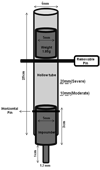A combined scoring method to assess behavioral recovery after mouse spinal cord injury
- PMID: 20188770
- PMCID: PMC2879004
- DOI: 10.1016/j.neures.2010.02.009
A combined scoring method to assess behavioral recovery after mouse spinal cord injury
Abstract
Although the rat has been the predominant rodent used to investigate the pathophysiology and treatment of experimental spinal cord injury (SCI), the increasing availability of transgenic animals has led to greater use of mouse models. However, behavioral assessment after SCI in mice has been less extensively investigated than in rats and few studies have critically examined the correlation between behavioral tests and injury severity or tissue damage. The present study characterized hindlimb functional performance in C57Bl/6 mice after contusion SCI at T9 using the weight drop method. A number of behavioral tests were examined with regard to variability, inter-rater reliability, and correlation to injury severity and white matter sparing. Mice were subjected to sham, mild-moderate or moderate-severe SCI and evaluated at day 1 and weekly up to 42 days using the Basso mouse scale (BMS), ladder climb, grid walk, inclined plane, plantar test and tail flick tests. The ladder climb and grid walk tests proved sub-optimal for use in mice, but modifications enhanced their predictive value with regard to injury severity. The inclined plane, plantar test and tail flick test showed far too much variability to have meaningful predictive value. The BMS score proved reliable, as previously reported, but a combined score (BLG) using BMS, Ladder climb (modified), and Grip walk (modified grid walk) provided better separation across injury levels and less variability than the individual tests. These data provide support for use of a combined scoring method to follow motor recovery in mice after contusion SCI.
Figures







Similar articles
-
Behavioral and histological characterization of unilateral cervical spinal cord contusion injury in rats.J Neurotrauma. 2006 Jan;23(1):36-54. doi: 10.1089/neu.2006.23.36. J Neurotrauma. 2006. PMID: 16430371
-
Anatomical and functional outcomes following a precise, graded, dorsal laceration spinal cord injury in C57BL/6 mice.J Neurotrauma. 2009 Jan;26(1):1-15. doi: 10.1089/neu.2008.0543. J Neurotrauma. 2009. PMID: 19196178 Free PMC article.
-
Functional consequences of ethidium bromide demyelination of the mouse ventral spinal cord.Exp Neurol. 2013 Sep;247:615-22. doi: 10.1016/j.expneurol.2013.02.014. Epub 2013 Mar 4. Exp Neurol. 2013. PMID: 23466931 Free PMC article.
-
Adaptation of a ladder beam walking task to assess locomotor recovery in mice following spinal cord injury.Behav Brain Res. 2007 Feb 27;177(2):232-41. doi: 10.1016/j.bbr.2006.11.042. Epub 2007 Jan 2. Behav Brain Res. 2007. PMID: 17197044 Free PMC article.
-
Prolonged acute intermittent hypoxia improves forelimb reach-to-grasp function in a rat model of chronic cervical spinal cord injury.Exp Neurol. 2021 Jun;340:113672. doi: 10.1016/j.expneurol.2021.113672. Epub 2021 Feb 27. Exp Neurol. 2021. PMID: 33652030 Review.
Cited by
-
The multifaceted effects of agmatine on functional recovery after spinal cord injury through Modulations of BMP-2/4/7 expressions in neurons and glial cells.PLoS One. 2013;8(1):e53911. doi: 10.1371/journal.pone.0053911. Epub 2013 Jan 21. PLoS One. 2013. PMID: 23349763 Free PMC article.
-
Zinc deficiency impairs axonal regeneration and functional recovery after spinal cord injury by modulating macrophage polarization via NF-κB pathway.Front Immunol. 2023 Nov 8;14:1290100. doi: 10.3389/fimmu.2023.1290100. eCollection 2023. Front Immunol. 2023. PMID: 38022538 Free PMC article.
-
The SDF-1/CXCR4 axis promotes recovery after spinal cord injury by mediating bone marrow-derived from mesenchymal stem cells.Oncotarget. 2017 Feb 14;8(7):11629-11640. doi: 10.18632/oncotarget.14619. Oncotarget. 2017. PMID: 28099928 Free PMC article.
-
Neuropathological differences between rats and mice after spinal cord injury.J Magn Reson Imaging. 2010 Oct;32(4):836-46. doi: 10.1002/jmri.22323. J Magn Reson Imaging. 2010. PMID: 20882614 Free PMC article.
-
Macrophage centripetal migration drives spontaneous healing process after spinal cord injury.Sci Adv. 2019 May 15;5(5):eaav5086. doi: 10.1126/sciadv.aav5086. eCollection 2019 May. Sci Adv. 2019. PMID: 31106270 Free PMC article.
References
-
- Ballermann M, Fouad K. Spontaneous Locomotor Recovery in Spinal Cord Injured Rats Is Accompanied by Anatomical Plasticity of Reticulospinal Fibers. Eur J Neurosci. 2006;23:1988–1996. - PubMed
-
- Ballermann M, Tse AD, Misiaszek JE, Fouad K. Adaptations in the Walking Pattern of Spinal Cord Injured Rats. J Neurotrauma. 2006;23:897–907. - PubMed
-
- Basso DM, Beattie MS, Bresnahan JC. A Sensitive and Reliable Locomotor Rating Scale for Open Field Testing in Rats. J Neurotrauma. 1995;12:1–21. - PubMed
-
- Basso DM, Beattie MS, Bresnahan JC. Graded Histological and Locomotor Outcomes after Spinal Cord Contusion Using the Nyu Weight-Drop Device Versus Transection. Exp Neurol. 1996;139:244–256. - PubMed
Publication types
MeSH terms
Grants and funding
LinkOut - more resources
Full Text Sources
Medical

